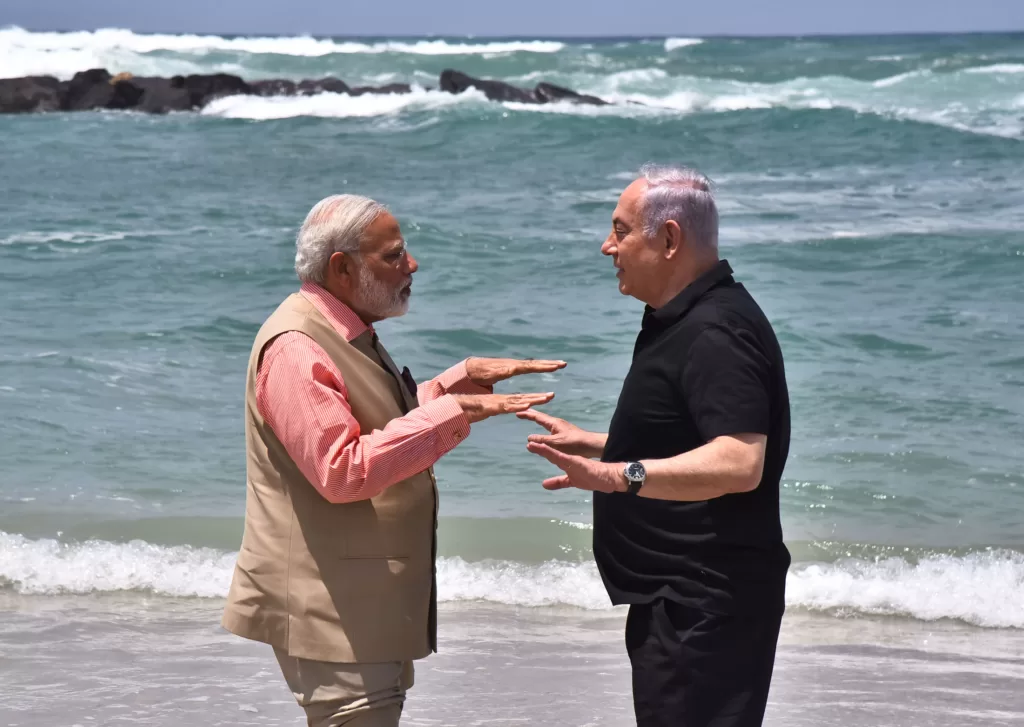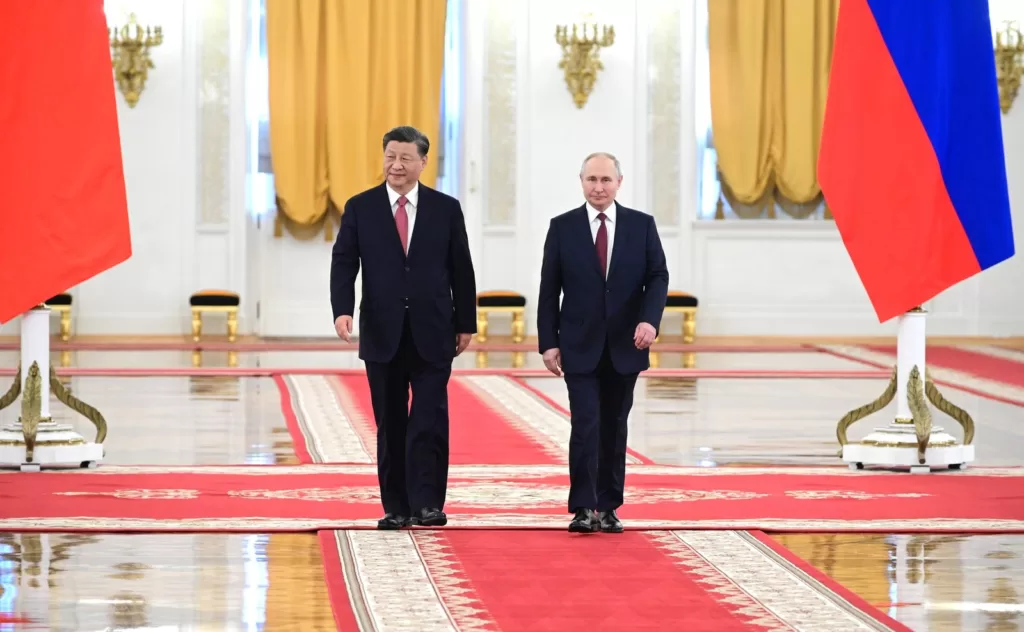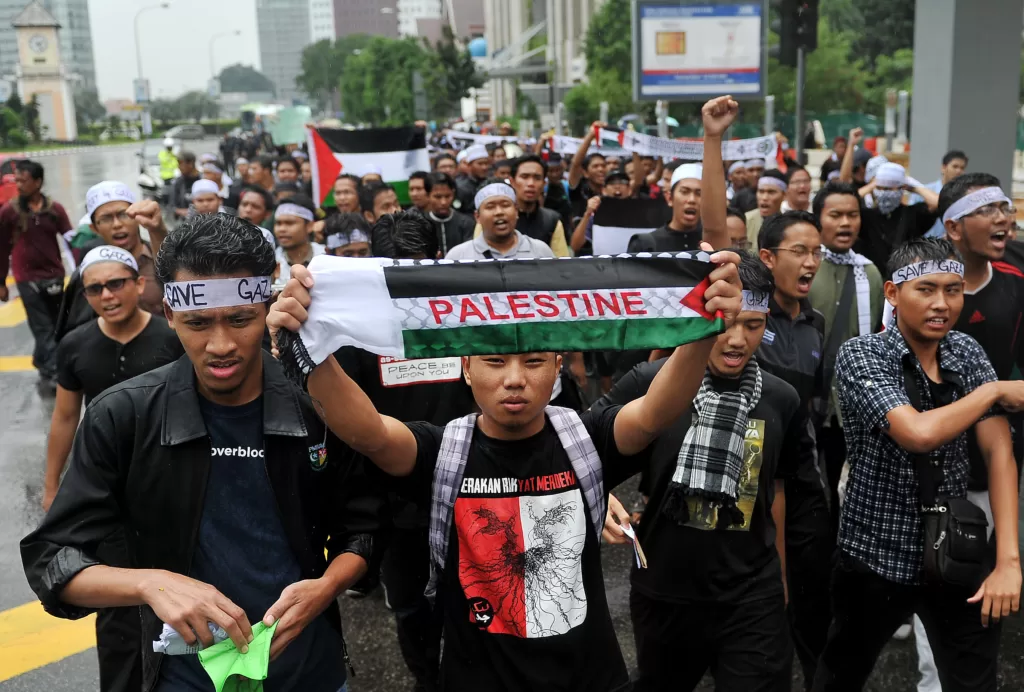Relations with Israel and Palestine along two independent tracks may not be tenable amid the current crisis, but India hasn’t stopped trying.
 Indian Prime Minister Narendra Modi and Israeli Prime Minister Benjamin Netanyahu at Olga Beach, Israel, 6 July 2017. : Prime Minister’s Office , via Wikimedia Commons (GODL-India)
Indian Prime Minister Narendra Modi and Israeli Prime Minister Benjamin Netanyahu at Olga Beach, Israel, 6 July 2017. : Prime Minister’s Office , via Wikimedia Commons (GODL-India)
Relations with Israel and Palestine along two independent tracks may not be tenable amid the current crisis, but India hasn’t stopped trying.
India has a long history of relations with both Israel and Palestine, informed by its own struggle for independence. But the confusing signals it has sent through various statements and actions put forth in the recent weeks of this deadly war hardly reflect a clear diplomatic strategy.
Any policy that ignores historical and structural factors and stresses only on episodic events will not be of great help with regard to the conflict or to the politics of the region as a whole.
Immediately after the attack on Israel by Hamas on 7 October, India’s Prime Minister Narendra Modi expressed shock at what he called ‘terrorist attacks in Israel” in his tweet asserting that “we stand in solidarity with Israel at this difficult hour”.
Yet within a few days, on 12 October, the Ministry of External Affairs reiterated India’s earlier commitment to “establish a sovereign independent and viable state of Palestine, living within secure and recognized borders, side by side with Israel”. He also asserted that this is India’s “longstanding and consistent” position on Palestine.
There were conflicting positions on the unfolding humanitarian crisis. When Israel’s war on the Gaza Strip intensified with huge loss of Palestinian civilians, on 22 October, the Indian government sent humanitarian aid consisting of medical and disaster relief to Gaza.
But, on 27 October, India abstained during a UN General Assembly vote calling for a humanitarian truce between Israel and Hamas. India’s Deputy Permanent Representative to the United Nations, Yojana Patel, explained the abstentions by referring to terrorism: “terrorism is a malignancy and knows no borders, nationality or race.”
There was obviously an unwillingness to make Israel uncomfortable. There was sharp criticism by Indian opposition parties on the government’s position in the General Assembly. Invoking the policy of fighting terrorism as a major prism of looking at a longstanding conflict by sidelining the core political issues may not help in the long run.
India’s positioning as a Global South power and as a significant member of BRICS did not compel it to adopt a unified stance in the UN with other BRICS members, as it took a position in sharp contrast to the other member states. The history of India’s leadership in highlighting the Palestinian cause in the Non-Aligned Movement and of sponsoring pro-Palestine resolutions in international bodies stands in sharp contrast with its current position, which seems not to adhere to any meaningful normative content in foreign policy.
India was one of the first countries to recognise Palestinian statehood even when Palestinian territories of West Bank, Gaza Strip and East Jerusalem remained under Israeli occupation. In the past, Indian policy statements on Palestine referred to East Jerusalem as part of a future Palestinian state. Recent pronouncements do not mention Jerusalem at all.
India’s position on Palestine emerged from the colonial experience of the two peoples. Anti-British struggle in India and the opposition to the British mandate and European Jewish settlements in Palestine shaped, in part, India’s support to the struggle of the Palestinian Arabs.
Jawaharlal Nehru’s criticism of the very idea of the Mandatory system emanated from such a position. Mahatma Gandhi’s writings and comments reflected the commonalities of the colonial situation. His opposition to the idea of political Zionism and a Jewish state in Palestine is well-known. The oft-quoted lines from his editorial in Harijan in 1938 that “Palestine belongs to the Arabs in the same sense as that England belongs to the English and France to the French” bear witness to this. He added that “surely it would be a crime against humanity to reduce the proud Arabs” by converting Palestine into a Jewish national home.
Things changed fast. After World War Two, Britain referred the Palestine question to the UN, which in turn constituted the Special Commission on Palestine in 1947. India was a member of the Commission, where it opposed the partition of Palestine into Jewish and Arab entities. It suggested a plan by which both Jewish and Arab populations would live under a federal system. The terrible unfolding of the partition of India was also significant in its position on Palestine.
The establishment of the state of Israel in 1948 and the global sympathy for the Jewish people after the Holocaust influenced discussions in independent India, which recognised the state of Israel in 1950, even though fuller diplomatic relations were established only in 1992. India-Israel relations grew very fast in the last three decades, especially in defence cooperation.
Since the Bharatiya Janata Party-led government came to power in 2014, there has been further intensification of ties with Israel while maintaining the position that India supports a two-state solution to the Israel-Palestine conflict.
The attempts at ideological mobilisation in domestic politics have had an impact on policies with respect to the conflict. There was more emphasis on de-hyphenation – asserting that relations with Israel and with the Palestinians were two independent, separate tracks, instead of treating the Israel-Palestine conflict as interconnected.
Problems regarding de-hyphenation emerge every now and then. The Ministry of External Affairs statement at the start of the current conflict, proclaiming the government’s support to Palestinian statehood, immediately after the Prime Minister’s statement supporting Israel is such a case.
While such endeavours could be called ‘compensatory diplomacy’, intended to have a balancing effect, attempts at de-hyphenation by ignoring the reality of occupation would be a futile exercise.
A K Ramakrishnan is a professor at the Centre for West Asian Studies, School of International Studies, Jawaharlal Nehru University, New Delhi.
Originally published under Creative Commons by 360info™.










